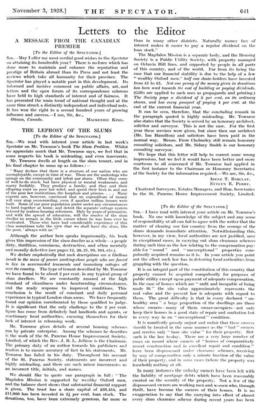THE LEPROSY OF THE SLUMS
[To the Editor of the SPECTATOR.] SIR,—We read with interest your article in last week's Spectator on Mr. Townroe's book The Slum Problem. Whilst
we appreciate much that Mr. Townroe says, we feel that in some respects his book is misleading, and even inaccurate. Mr. Townroe dwells at length on the slum tenant, and in his final chapter he sums up as follows :-
"Many declare that there is a stratum of our nation who are unemployable, except in time of war. These are the underdogs who sponge on the community and infest our slums. Often they come of well-to-do stock, but have physical or mental weaknesses, and marry foolishly. They produce a family, and they and their offspring exist on poor law relief, and spend their lives in and out of the poor law institutions, the hospitals and prisons. . . . Many experts are, however, convinced that no expenditure of money will ever stop overcrowding, even if another million houses were built. Some of our poor population prefer under any circumstances to herd together at home, and detest the separate cottage system beloved by zealous housing reformers. Only by years of persuasion, and with the spread of education, will the resolve of the slum dweller to remain in the little corner where he was born ever bo eradicated. Those who have had considerable experience of this class sometimes take the view that we shall have the slum, like the poor, `always with us.' " Although the author here speaks impersonally, his book
gives this impression of the slum dweller as a whole—a people dirty, thriftless, verminous, destructive, and often mentally and morally defective (see pages 12, 20, 21, 99, 104, etc.).
We declare emphatically that such descriptions are a libellous insult to the mass of poorer working-class people who are forced to live in overcrowded tenements and insanitary cottages all over the country. The type of tenant described by Mr. Townroe we have found to be about 2 per cent. in any typical group of slum dwellers. We are constantly amazed at the high standard of cleanliness under heartrending circumstances, and the ready response to improved conditions. This conclusion is the result of constant and daily personal experience in typical London slum areas. We have frequently found our opinion corroborated by those qualified to judge. It is significant that the only challenge to the 2 per cent. figure has come from definitely bad landlords and agents, or reactionary local authorities, excusing themselves for their lack of interest in rehousing work.
Mr. Townroe gives details of several housing scheme run by private enterprise. Among the schemes he describes is the work of the St. Pancras House Improvement Society, Limited, of which the Rev. J. B. L. Jellicoe is the Chairman.
The primary duty of an author towards his publishers and readers is to ensure accuracy of fact in his statements. Mr. Townroe has failed in his duty. Throughout his account of the St. Pancras Society, statements are incorrect and highly misleading, and there are such minor inaccuracies as an incorrect title, initials, and names.
We should like to quote one paragraph in full : " The Magdalen Mission is supported by wealthy Oxford men, and the balance sheet shows that substantial financial support is given. The trust has a share capital of £36,454, and 111,900 has been invested in 21- per cent. loan stock. The donations, too, have been extremely generous, far more so than in many other districts. Naturally money free of interest makes it easier to pay a regular dividend on the loan stock."
The Magdalen Mission is a separate body, and the Housing Society is a Public Utility Society, with property managed on Octavia Hill lines, and supported by people in all parts of this country, and of the world. Far from its being the case that our financial stability is due to the help of a few " wealthy Oxford men," half our share-holders have invested from £1 to £5. Not one penny of the money given in donations has been used towards the cost of building or paying dividends. (Gifts are applied to such uses as propaganda and printing.) The Society pays a dividend of 3 per cent. on its ordinary shares, and has every prospect of -paying 4 per cent. at the end of the current financial year.
It can be seen, therefore, that the concluding remark in the paragraph quoted is highly misleading. Mr. Townroe also states that the Society is served by an honorary architect, solicitor and surveyor. This is not the case. For the first year these services were given, but since then our architect (Mr. Ian Hamilton) and solicitors have been paid in the normal way. Messrs. Frere Cholmeley still remain honorary consulting solicitors, and Mr. Sidney Smith is our honorary consulting surveyor.
We hope that this letter will help to correct some wrong impressions, but we feel it would have been better and more courteous to all concerned if Mr. Townroe had applied in the first instance to the Chairman or Honorary Secretaries of the Society for the information required.—We are, Sir, &c., IRENE T. BARCLAY. EVELYN E. PERRY. Chartered Surveyors, Estates Managers, and lion. Secretaries to the St. Pancras House Improvement Society, Limited,


















































































































 Previous page
Previous page